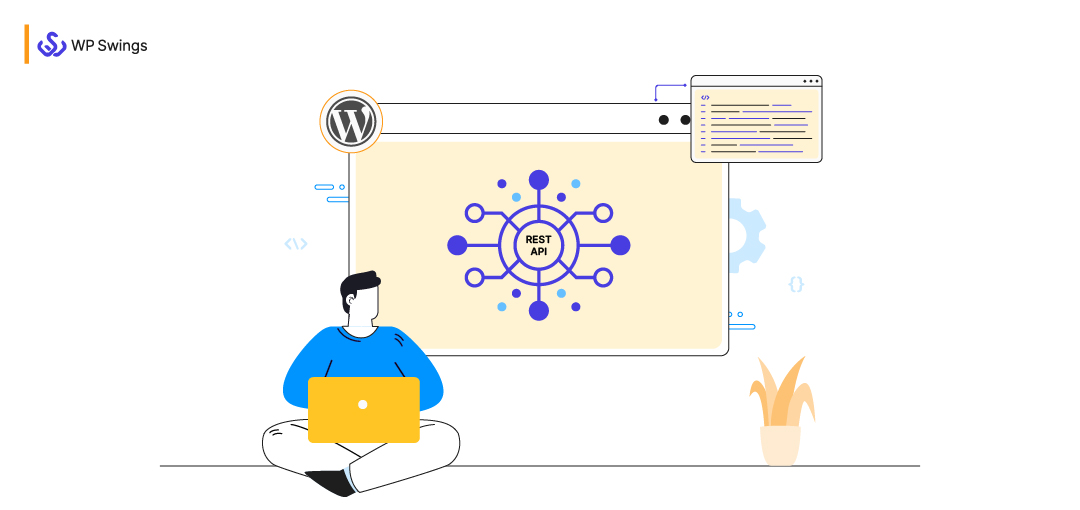
If you’ve used the robust features and capabilities of eCommerce REST API for your online store, then the name REST API might not sound unfamiliar to you.
There was no doubt that WordPress stumbled. As JavaScript’s popularity on the web to create immersive, interactive experiences increased, WordPress needed to offer new ways for users and developers to interact with its content.
We’ll go through some amazing new capabilities of the eCommerce REST API in this post to show why WordPress is still at the forefront of web development. If you missed it, please return to our earlier post where we discussed them:
If You Missed the First Chap on eCommerce REST API, It Is Here. ….The Way to Go..
REST API in eCommerce!!
Can turn up your ordinary WooCommerce website into a full-fledged application platform. As a result, opening doors to a broader interaction with other applications present over the internet….
So, to help you stay on track and comprehend in the best way possible, how about a quick refresher of my prior post?
Our previous post on the eCommerce REST API was entirely devoted to our ongoing research as well as interest in the RESTful API functionalities that have been growing steadily over the years and have assisted an increasing number of eCommerce stores in moving beyond their routine operations and performing magic.
In the blog, we covered all the fundamental setup checks, including GET, POST, DELETE, and CREATE. These CRUD operations all handle JSON and are very important components of RESTful API queries. We also discussed the main advantages and briefly touched on some potential future developments. That blog article on our site received a tons of views and comments.
However, because there is still a great deal of room to fill, we came up with the idea for an additional post on the same subject that ingeniously hides the material under the cover. So, that’s the basic premise of the narrative in this piece.
Let’s get right to writing the piece and stop wasting time on the rest of this.
Why Do Retailers Use eCommerce REST APIs? What Instances From Actual Life Do It Support?
Think of the Internet as a dining establishment. You settle in, go through the menu, and then place your order. You don’t go right up to the cook, do you? A waiter acts as a liaison between you and the kitchen instead.
Application programming interfaces, or APIs, are subject to the same rules. They make it easier for apps and other programmes to access data and communicate with one another, but just like secure restaurant transactions rely on trust, online systems need regular web application penetration testing to ensure APIs don’t become an entry point for attackers. Let’s use the “Add to Cart” button on an online store as an example. Once an API informs the website to add the product to your cart, you see an updated version of the product on the screen. Penetration testing helps identify vulnerabilities in these APIs before cybercriminals can exploit them. By simulating real-world attack scenarios, it ensures that security flaws are detected and fixed early, strengthening the overall resilience of the system.
The Internet of Things (IoT), Artificial Intelligence (AI), and other modern eCommerce-supporting technologies are likely familiar to you (AI). However, you must actually bring them together.
REST API in ACTION
You can find REST APIs all over the web, you’ve likely used some today without realizing it likewise Gutenberg….. Therefore, we came up with a small list of such examples of REST APIs in use—
SOCIAL MEDIA
I. Twitter enables information such as tweets, users, tweet streams, and more to be retrieved by publishing websites. Instead of using the website interface, programmers can post tweets using the API that is restful one.
II. Information about profiles, pictures, and videos are accessible through the Instagram Basic Display API. This Rest API and others can be used to create apps that extract this user information and incorporate it into your own offerings. For business Instagram accounts to manage their online activities, Instagram also offers a Graph API.
III. Customers can request details about artists, songs, albums, and playlists on Spotify‘s platform using its web API. Additionally, you can use it to shuffle tracks, play and pause music, add songs to playlists, and do a lot more things.
GENERAL
I. Travel and Ticketing websites can leverage the flight times and prices that airlines make available through APIs.
II. Weather Apps use open APIs that exchange weather data to display weather information.
III. In order for mapping and navigation apps (like Google Maps) to use them, public transportation agencies typically make their data publicly available in real-time via APIs.
OTHER
I. All of HubSpot‘s APIs follow REST standards and were created to allow for reliable integrations that would maximize the benefits of using HubSpot’s solutions for businesses.
eCommerce REST APIs promise user friendliness, secure online buying, and less complicated transactions. Developers can use eCommerce APIs to move data from one piece of software to another, then use that data in a single user interface.
Isn’t that convincing enough to please you all???….If not…continue reading.
What’s There in the eCommerce Rest API for Your eCommerce Store???
After years of growth, the eCommerce industry has reached maturity. In order to enhance the customer purchase experience, contemporary traditional businesses are increasingly changing their innovations and strategies. eCommerce APIs are discovered to be perfect for this.
Let’s examine how businesses are now using Restful APIs—
For Recognition of Their Excellent Business Integration
Organizations need to be able to easily comprehend client journeys as they begin to use increasingly varied digital engagement strategies to foster their customer relationship.
Businesses may integrate and monitor client contact across all digital channels with the aid of the eCommerce API. Additionally, the eCommerce API helps automate logistics, shipping, payments, and security. It can be integrated with equipment and software to speed up the sales and marketing processes.
The use of APIs to simplify the management of duties related to eCommerce in modern business has a significant impact. APIs have become a crucial component of the digital revolution as the significance of AI and machine learning has increased and the digitization of business and human behavior has become more widespread.
Tired of Manual Workflows That Are Prone to Errors or Need a Closer Connection to Your Customers & Partners?
Facilitates Usability for Headless eCommerce
Retail operations conducted online are becoming more complicated and larger. The solution to the expansion of digital commerce is the headless eCommerce API method, which enables businesses to offer immediate personalization outside of the website interface.
Headless eCommerce (also known as headless CMS) is the new modern approach to sales management and eCommerce. This is a cross-platform common API approach to integrate with eCommerce websites. It is an entirely stand-alone, self-sufficient solution.
Headless CMS integration is not possible with headless eCommerce APIs. They enable you to advise your eCommerce platform’s front end to call without refreshing the page. This makes it simple to convert your website into an order fulfillment product for cloud-based sales.
Effective for PWA (Progressive Web App) or the Native Apps
B2B merchants are seeking ways to create better eCommerce experiences for their consumers in light of the rising popularity of mobile-first tactics. Progressive Web Apps offer great prospects for innovation in eCommerce because of its push alerts, micro-billing, and deep customization.
PWAs can help shops re-engage website visitors by centralizing the discovery process, offering a more useful and standardized experience, and providing these benefits. Additionally, PWAs can be used in conjunction with your eCommerce engine to produce leads for your company.
For B2B professionals, Progressive Web Apps have the potential to enhance the eCommerce experience. The future of eCommerce is in progressive web apps, which also represent a thriving new business environment online. When properly developed, PWAs enable you to make the most of the material on your website, allow users to contribute to it, and engage in a mobile-friendly, effective digital environment.
Is eCommerce Rest API Really Beneficial for Your eCommerce, if Yes Do They Really Count???
Restful APIs can be useful for eCommerce businesses in a variety of ways. Selling goods on websites like eBay, Amazon, and Facebook can enhance earning possibilities, strengthen a company’s reputation, and make product searches easier.
Keep in mind that when a user loads your shop or makes API requests, you must guarantee a quick response. Implementing Magento performance optimization advice or CMS-specific optimizations is therefore advised.
Now let’s proceed to some of the reasons why APIs are so vital to eCommerce companies—
eCommerce REST API in Enhancing an Application’s or Website’s Capabilities
APIs link different programme parts together. They accept and answer requests, which enables these components to communicate with one another.
This can speed up a program’s or website’s performance, enabling you to do activities more quickly. Additionally, it facilitates information exchange. Each of these elements boosts a developer’s output.
Connecting Multiple Devices Effortlessly
eCommerce stores can use the eCommerce Rest API to efficiently link their main website with a variety of devices. It is simple to integrate with various business-specific software or tools, make existing legacy solutions compatible, and maintain seamless connectivity with various devices, including wearables.
To streamline their operations across many platforms, WooCommerce firms do not need to spend any additional time or money.
Security and Protection
How do APIs increase the security of software systems? Users can safely request data from your systems with their assistance. Your eCommerce data can be protected using security measures like encryption implemented via APIs.
Assume that you have sent a request. You don’t directly link to the server. Instead, you send the API small amounts of data, which it then sends to the server, which then responds to your request. This design style can lessen instances of data breaches or unauthorized access to the backend of a server.
Simple to Develop Mobile Native Apps
Anyone looking to develop mobile apps will find the eCommerce REST API to be fantastic news. The main driver of heavy mobile usage is still applications. With the use of a RESTful API, WooCommerce can now quickly connect applications with the live website.
Build Mobile Applications Faster Than Ever With WP Swings
Hey Buddy!!!
With extensive experience developing mobile apps, WP Swings is prepared to help. Our team will work with you to build usable, seamless experiences across all devices and make the most of mobile technology for your company.
You won’t find anything better than APIs for boosting store inventory, security, or data demands. What could you do to make your shop expand more quickly? because you don’t need to account for new code for each product or client.
Without changing the current software or hardware, APIs let you connect to any new system. To handle more complex transactions, you’ll only need to write a few lines of code.
Coordination Across Multiple Platform
eCommerce Rest API compatibility with devices running on various different platforms is its most remarkable and fantastic feature. You can use your WooCommerce dashboard, for instance, to access your data from any other third-party application. By simply including a Rest API on your WooCommerce website, you can integrate with that application directly using a JSON request.
In the past, WooCommerce businesses had to invest a lot of time and energy into creating unique APIs for these situations.
Easy Synchronization
You can choose and choose which components of your online store to use from other applications and programmes thanks to API integration. It implies that you can create a platform to accommodate the demands of your own business and properly manage your operational activity.
What are the advantages of integrating systems for a business? In order to manage data, shipping channels, products, and services successfully for other businesses, it can connect to their software and apps.
Now, Wrapping up the REST…
Given the prevalence of eCommerce REST APIs in modern software development, all programmers should at the very least be conversant with their basic principles and, preferably, have some experience using them to create native apps out of them.
If you can, use examples of times you’ve used a REST API to support your points. This demonstrates that you are not just knowledgeable about this potent technology, but also have experience using it in the real world.
We’ll try to come up with much more refreshing and insightful content related to REST in our upcoming posts…. Till then stay tuned with our blogs and keep experimenting with REST. All the best!
Happy RESTing !!!
















Oh! That’s cool, we need to try out this API to our model projects before making use of it over to the clients.
Hey Dezvolta,
That sounds pretty fantastic.
I value the time you spent reading and enjoying our blog. This is just wonderful. We frequently write similar posts, so please keep a watch out.